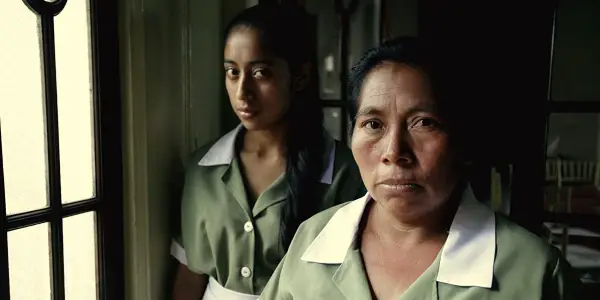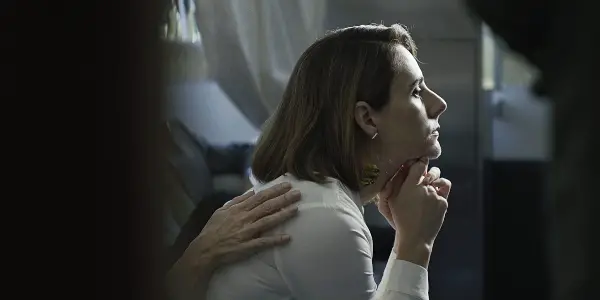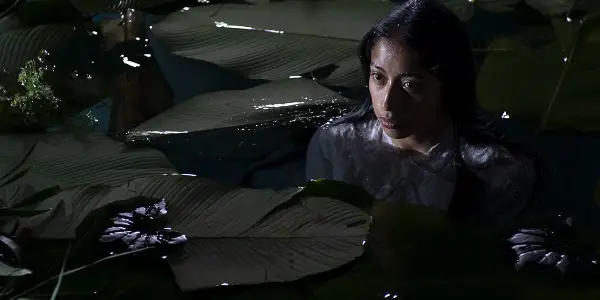LA LLORONA: A Haunting Reworking That Encompasses Real-Life Tragedy

Andrew Stover is a film critic/writer from the Chicagoland. His…
Just last year, Guatemalan writer-director Jayro Bustamante’s meditative and heavy-hearted Tremors (Temblores) told the story of a gay man in contemporary Guatemala City with elegantly exhumed empathy and heartache. The latest from Bustamante, La Llorona, is a tonally audacious and proudly solemn horror film infused with transfixing political weight. Not to be confused with Michael Chaves’ The Curse of La Llorona, the undistinguished horror film released last year, Bustamante’s La Llorona is not your typical horror fare.
As the horror genre has shown viewers time and time again, the genre can be reshaped in ways to incorporate real-life issues or societal events into the horror-imbued concoction for enhanced vitality. In Jennifer Kent’s The Babadook, Kent deftly captured the destructive essence of grief. Wes Craven’s The People Under The Stairs was supposedly based on a true story, and it examined underclass oppression and child abuse — a prolific problem that affects many children around the world.
Robert Egger’s The Witch not only toyed with witchcraft but with incipient mania and Calvinist dogmatism on the edge of a primordial New England forest, as a pious family is consumed by panic and betrayal. Characters in horror films are either consumed by magnified emotions, scheming spirits, or hungry murderers, but what about the beast that is generational trauma? Bustamante’s La Llorona dares to tackle that beast in horror fashion.

The mythology behind La Llorona, or The Weeping Woman, is rooted in tragedy, sorrow, and regret. The perennial bedtime tale tells the mournful story of a young woman who’s deserted by her husband, drowns her two children in the river, and commits suicide. Now deceased, the woman must roam the earth and haunt unsuspecting victims for eternity. The teary-eyed spirit is out to fulfill an incessant task, although the contents of Bustamante’s reinterpretation of the eldritch spirit has less to do about the spirit’s shadowy genesis, and more about utilizing the Latin American folklore to support a greater cause: to obtain justice for the Mayans who died under the leadership of Enrique Monteverde (Julio Diaz), a fictitious incarnation of Guatemalan’s former president Efraín Ríos Montt.
La Llorona Is Out To Avenge The Dead & Punish The Guilty
In the opening minutes, the family of retired General Enrique Monteverde is hiding in their opulent Guatemala City mansion as protests erupt outside. The women and men are hunkering down in separate rooms. Enrique’s wife, Carmen (Margarita Kenéfic), is in one room reciting incantations with other women, while Enrique is in another room smoking cigars and drinking whiskey with his officers. Enrique and Carmen’s daughter Natalia (Sabrina De La Hoz) is secured in another room with her child, Sara (Ayla-Elea Hurtado).
There’s a specific reason for these protests: General Enrique Monteverde is being tried for the genocide of the Mayan people under his leadership during the 1980s. He appears before a war-crimes tribunal, and witnesses come forward to tell their devastating experiences with Enrique’s vile rage against the country’s indigenous population. From the burning of their crops and homes to the assault of every woman and child, one indigenous woman does not let one detail go unsaid. At the end of the trial, Enrique is found guilty.
Upon arriving at his comfortable estate, Enrique is faced with vociferous protesters craving retribution. Several of them hold posters of missing or deceased loved ones, who are unable to make peace because their bodies can’t be found or their deaths can’t be rightfully avenged. With the protesters setting camp outside, the family is trapped in their mansion. The protesters make their presence known by shouting, singing, and staring them down, all of which the family eagerly tries to disregard as foolishly rebellious behavior. But the privileged family will be forced to reckon with their past, as the arrival of a young Mayan woman named Alma (Maria Mercedes Coroy) trudges through the crowd of protesters with a striking gaze that immediately catches Enrique’s attention. Alma is ultimately hired as a new housemaid.

Enrique begins hearing noises and seeing creepy visions. These abstruse occurrences are either traced back to a malefic entity or his guilty subconscious. Whilst the casual horror viewer would like to believe the former, La Llorona does not latch onto horror conventions; there are no jump scares, creaking doors, head-turning twists, or flickering lights. There is, however, deep-seated trauma and paranoia that lingers.
On the other side of the pool, Alma and Sara become friends, and for whatever reason (other than being an obvious nod to the folklore), Alma is teaching Sara how to hold her breath underwater. Carmen undergoes visions of two Mayan children in the midst of the genocide. And Natalia can’t help but question her family’s self-avowed innocence.
These Tears (And Crimes) Won’t Fade Out Of Existence
Not everything stays in the past, nor should it. Genocide is a sadistic act commonly executed under the veneer of fear and duplicity and is steered by false beliefs. The barbaric death of thousands of Mayans is more than enough to summon La Llorona, and the tears that are shed have more impact.
La Llorona is an effectively subtle political horror venture that transpires in a controlled environment permeated with trickling suspense and a richly foreboding climate. Sebastián Muñoz’s unassuming production design yields a humble mansion of horrors. Nicolás Wong’s cold cinematography gently flows through the mansion, manifesting itself as a passive observer to Enrique’s disquieted descent into madness and Carmen’s nightmarish journey in divulging Enrique’s barbarous core, and experiencing it firsthand.
Julio Diaz perfectly embodies the role of Enrique, exuding a deadly kind of silence and restraint. As Alma settles in, that’s when Enrique gradually (and suspiciously) deteriorates. Slowly but surely, the scarily collected Enrique isn’t able to uphold a strong exterior, let alone an unperturbed state of mind. Enrique is guilty and cowardly, and a reckoning is overdue. Woefully for the loved ones around him, they will irrevocably suffer from his sordid deeds for eternity. Enrique’s legacy is tainted by generational turpitude that won’t recede for anyone in the family, not even for little Sara.
Maria Mercedes Coroy naturally assumes the role of Alma, the reserved servant who hypnotizes with piercing, unyielding stares, a slender frame, and long dark hair. The kernel of fear seems to originate from Alma and from the time she arrived, rendering her intentions temptingly unclear. The tenebrous imagery that coincides with Alma almost every time she’s on-screen is often emblematic, kindling modestly elaborate hallucinations designed to spook Enrique, unmask his complicity, and drive him down a path of paranoia

One chilling sequence, in particular, sees Enrique walking into a bathroom to see the fearfully cryptic Alma sitting on the edge of the bathtub. The water’s overflowing and Alma is seemingly soaking a piece of clothing, and she doesn’t say a word to Enrique. The mysterious, gorgeous, and minacious visuals cast a spell, further intensified by a skulking camera that slowly aligns itself with the central action. Alma is almost always near a body of water, amplifying our suspicions that she may be La Llorona or she brought the spirit with her. Alma is not a fleshed-out character, instead, she remains a hypnotic token of the Mayan people’s anguish.
Margarita Kenéfic gives the most memorable performance as Enrique’s wife, Carmen. For the majority of the film, Carmen possesses her own prejudices against the Mayan people, convinced that her husband’s infidelity is the Mayan people’s own doing. Enrique is witnessing the effects of dementia, whereas Carmen withstands feverish nightmares of two Mayan children. Carmen’s engineered nightmares will hopefully enlarge her outlook on the indigenous people, and force her to acknowledge the veracity of Enrique’s war crimes.
While there are religions in which someone’s soul can be cleansed, Enrique left a trail of carnage and ruin behind that can’t simply be prayed away. Anchored by an impressive ensemble, scrupulous framing, and a heady screenplay, La Llorona won’t fade out of existence. The deaths of the Mayan population will not be forgotten, as the survivors will make sure of it. And for those who had a hand in the genocide, their involvement will not be forgotten, as La Llorona will not forget, or forgive.
Conclusion: La Llorona Is A Grim & Evocative Political Horror Film
Jayro Bustamante’s La Llorona is a staid screed on injustice, which reveals itself to be purposefully spiritless and deeply ruminative. While the pace can be construed as frustratingly inert and the horror nonexistent, Bustamante beautifully sustains a palpably sinister atmosphere built precisely on a real act of savagery that occurred in Guatemala’s history. Some horror is fleeting, but La Llorona’s horror is real. The tears won’t dissipate, they will only collect with time.
Have you seen La Llorona? If not, are you interested in seeing it now? Let us know in the comments!
La Llorona is available to watch on Shudder
Watch La Llorona
Does content like this matter to you?
Become a Member and support film journalism. Unlock access to all of Film Inquiry`s great articles. Join a community of like-minded readers who are passionate about cinema - get access to our private members Network, give back to independent filmmakers, and more.
Andrew Stover is a film critic/writer from the Chicagoland. His film & TV reviews can be found on Film Inquiry & Film Threat.













